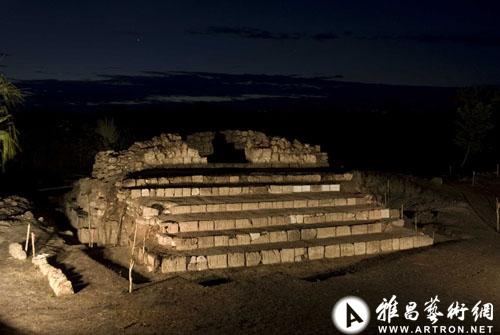编制机构:雅昌艺术市场监测中心(AMMA)

Stairway with Maya hieroglyphs . El Palmar archaeological zone, Campeche. Photo: Kenichiro Tsukamoto/INAH.
MEXICO CITY.- A stairway with Maya hieroglyphs was discovered at El Palmar Archaeological Zone, in southeast Campeche, by experts from the National Institute of Anthropology and History (INAH), the University of Arizona (UA) and the National Autonomous University of Mexico (UNAM), revealing the preliminary decipherment that this Maya city maintained contact with Calakmul, in Campeche, and Copan, Honduras, almost 1300 years ago.
Leaders of the project Javier Lopez Camacho, from the National School of Anthropology and History (ENAH) and Kenichiro Tsukamoto, from the University of Arizona (UA), announced that the 6-step stairway conserves 90 blocks with more than 130 glyphs that refer to events registered in the Classic Maya period (250-900 AD).
They remarked that although it is not the only hieroglyphic stairway discovered in the Maya Lowlands, (20 have been reported until now), the one at El Palmar is associated to the periphery of the site and to structures of modest dimensions; generally these stairways are linked to monumental buildings at the central area of the sites.
The report of this finding took place in June 2009 as part of a surface acknowledgement conducted by the archaeological team at El Palmar, where the presence of a small conjunct of archaeological vestiges, named Guzman Group, and the in situ evaluation of stones, suggested a possible association to a hieroglyphic stairway.
The field season took place in late 2010 and beginning of 2011 with funds from the National Geographic Society and the American Philosophical Society, INAH, UNAM and University of Arizona, supported by experts from the INAH National Coordination for Cultural Heritage Conservation and the Campeche INAH Delegation.
According to archaeologists Javier Lopez Camacho and Kenchiro Tsukamoto, the first 4 steps presented a good conservation state, while the 5th and 6th were fragments that needed conservation treatment.
All the blocks were registered in drawings and photographs, and their specific location with laser topographic instruments, before being moved to the archaeological camp as security measure. INAH restorers Yareli Jaidar, Diana Arano and Leticia Jimenez determined their conservation state.
Hieroglyph decipherment
Regarding the glyphic inscriptions, although it is a preliminary result, according epigraphist Octavio Esparza Olguin, from UNAM, the text refers to important events to understand history of the Maya Classic period (250-900 AD).
The hieroglyphic stairway of Guzman Group narrates the visit of foreign personages to El Palmar, maybe dignitaries; the creation of the steps carving is associated to a calendar wheel dated in Ajaw 18 Sak, equivalent to September 13th, 726 AD.
Information about the lords of the site is included, as well as contacts maintained with cities like Copan and Calakmul. The visit of the lords of Copan and Calakmul to El Palmar might have happened a decade before both cities were defeated, respectively, by Tikal and Quirigua (Guatemala) between 736 and 738 AD.
Other associated findings
The hieroglyphic stairway found is part of a simple base that measures 10 by 10 meters and is 3 meters high, adapted to support a vaulted building accessed by the hieroglyphic stairway. Archaeologist Luz Evelia Campaña was in charge of liberating and consolidating the structure.
Excavation included the base of the structure and a room atop. Two banquettes were identified at the extremes and on the floor, which shows evidence of having been burnt, ceramic fragments were also registered.
A burial with an offering was found under the floor of the room, contemporary to the construction of the stairway, dated in 8th century AD, according to stratigraphic analysis.
The burial is integrated by bone human remains, 2 vessels and other bones. Physical anthropologist Jessica Cerezo-Román, who conducted preliminary analyses, suggests that the remains correspond to a high-rank male, according to the jaw and jade incrustations in the canines.

hieroglyphs on the Maya stairway. Photo: Kenichiro Tsukamoto/INAH.
责任编辑:罗书银
推荐关键字:Archaeologists hieroglyphs Maya Stairway
注:本站上发表的所有内容,均为原作者的观点,不代表雅昌艺术网的立场,也不代表雅昌艺术网的价值判断。

网友评论仅供其表达个人看法,并不表明本站同意其观点或证实其描述。